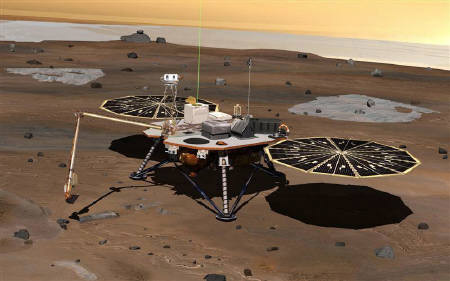After traveling for almost 10 months, Mars Phoenix Lander successfully landed on the Red Planet on Sunday on a mission to explore signs of life, according to NASA's Jet Propulsion Laboratory (JPL).

This artist's conception shows NASA's Phoenix Mars Lander as it monitors the atmosphere overhead with a laser radar and reaches out to the soil below with the spacecraft fully deployed on the surface of Mars. (NASA Handout)
With a speed of 13,000 mph when it reached the Martian atmosphere, the Phoenix Lander achieved a three-legged touchdown with the help of a parachute and pulsing retro rockets to slow down the spacecraft, the JPL said.
Scientists managing the flight at JPL in Pasadena, Los Angeles cheered in celebration as the Phoenix Mars Lander signaled back that it had survived Sunday's fiery entry.
"We're on the surface," Project Manager Barry Goldstein said.
When asked whether the landing could have gone any better, Goldstein said, "not in my dreams."
"Six minutes of sheer terror." That's what the usually understated scientists at the JPL were calling the landing of the Mars Phoenix Lander.
"Six months of boredom, in this case 10 months of boredom, followed by six minutes of sheer terror, just because we are landing on another world and it's completely autonomous -- there's no second chances," JPL Project Payload Manager Michael A. Gross said.
The 420-million-dollar mission blasted off last August on its nine-month, 422-million-mile flight from Earth to Mars.
Of 11 previous attempts that various nations have made to land spacecraft on Mars, only five have succeeded.
Phoenix landed farther north on Mars than any previous mission, at a site expected to have ice-rich permafrost beneath the surface, but within reach of the lander's robotic arms, which are used to search for signs of life, past or present.